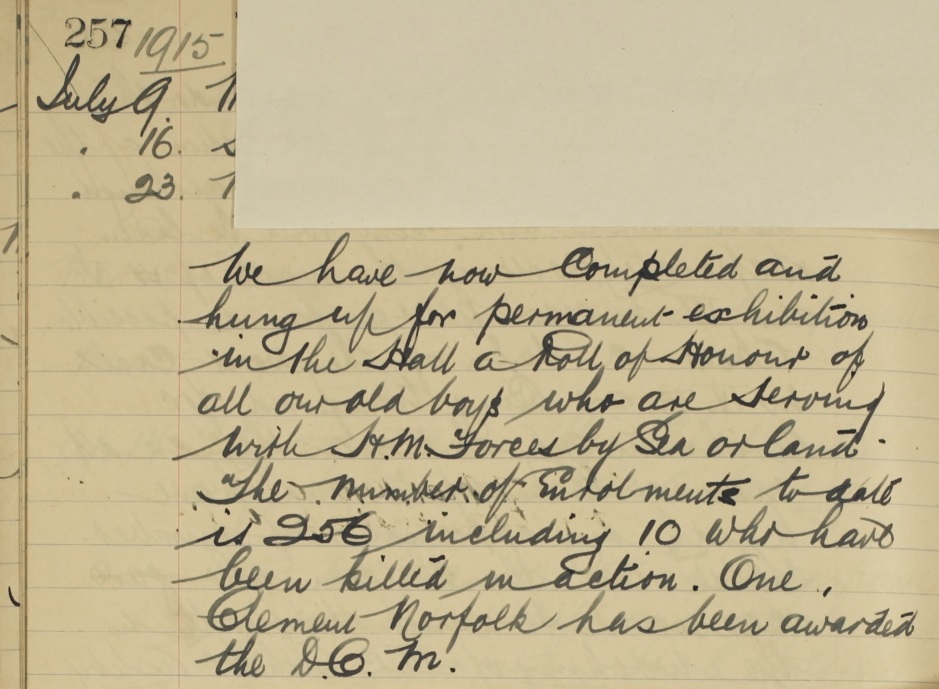This guest post is written by Laura Davison, project officer for We Will Remember Them. This HLF-funded school project has used documents stored at ERO and included a visit to ERO for the pupils involved.
Year 5 pupils at North Primary School in Colchester are working on the year-long project We Will Remember Them, researching the lives of the 50 former pupils who volunteered or were conscripted for action in the First World War. This innovative project explores how the discovery of locally relevant histories can engage and inspire pupils in responding to moments in the history of the First Word War.
The project was initially inspired by entries in the school’s log book written by the Head Master John Harper on 9 July 1915 and 11 November 1919:

Entry into the North Primary School log book by Head Master John Harper, describing a Roll of Honour which was to be hung permanently in the school hall, recording the names of former pupils who were serving with the armed forces in the First World War (EML 86/2)

Another entry by Harper, describing the observance of two minutes of silence on 11 November, and a display of photographs of the 50 men from the school who lost their lives in the way (E/ML 86/2)
The whereabouts of the Roll of Honour, installed in the school hall in 1915, is unknown. The funding from the Heritage Lottery Fund for We Will Remember Them will enable the school re-instate the Roll of Honour, restoring this object of heritage to its original setting within the school’s Grade II listed building. This will be supported by a showcase exhibition, publication and teachers’ pack narrating the untold stories of the former pupils’ lives and how they were affected by the First World War.
Headteacher Alan Garnett discusses the impact of the project for the school:
This history project captures all our past, present and future. The children are often told that our school is more than just a magnificent building – it is the stories of all its former pupils and staff. To work with a local historian to uncover the stories of those who lost their lives in that terrible war will bring national and local history alive to our pupils. And to have our Roll Of Honour re-made and restored to its rightful place in our school hall, well that will be a proud moment indeed.
The Year 5 pupils have worked with Historian Claire Driver to research and record the former pupils. All the hard work has paid off, as they have identified sixty-two pupils who served and died in the First World War. Each pupil is paired with a former pupil to develop individual case study. Claire has shown them how to use archive records from the School Log Book, the 1901 and 1911 census and military records. Using the 1897 map of Colchester, they have plotted where all the former pupils lived and identified what shops were in Colchester High Street in 1914. Gradually a picture is being formed of what it was like to live in Colchester 100 years ago.
Some of the fascinating facts the census records revealed were:
- People’s jobs – fishmongers, bakers, railway porters, tailors, police constables and printing apprentices
- How many people lived in a house – in some cases up to 11 people lived in a 2 bedroom Victorian terrace house
- Some of the pupils even came from the workhouse at St Mary’s
The children have been on an amazing journey building up an understanding of the social context of the school to promote awareness of their lives in the context of the First World War and the impact it had on the school and its locality.
An Open Day was held at the school, inviting local residents and families to get involved with the project and share their family stories and memories from the First World War passed down through generations.

The children are so proud to be working on this project because it really happened in our school. Year 5 Teacher Maria Gray discusses the project with Colchester MP Sir Bob Russell
Recently, the pupils visited Essex Record Office to view the collections and discover how historians use archives to support their research. Hannah Salisbury, Access and Participation Officer at ERO and project Historian Claire Driver introduced the pupils to the wealth of material available from the collections and explained how to use a range of historical sources to find out what life was like during WWI. The children were able to ask questions about their former pupil and in some cases looked on Ancestry too.
They focused on the two fascinating stories of the nurse Kate Luard and soldier Alf Webb using sound archives, letters and an interesting range of hands-on activities which even included bandaging at a WWI dressing station.
Using different historical sources, such as photographs, sound recordings, letters and even the original admissions register and log book from our school from over 100 years ago, the pupils were able to uncover more information about life during World War One. Maria Gray, Year 5 Teacher
Following on from the research, the pupils are now working with Creative Writer Baden Prince to creatively narrate in their own words each soldier’s individual story. They will then work with Photographer Georgia Metaxas to document their homes, making comparisons with then and now.
Do you have any information to help our research?
If you have any information or images in relation to North Primary School during the First World War please contact Laura Davison, Project Manager at northwewillrememberthem@outlook.com
We Will Remember Them project has been made possible by the funding award from Heritage Lottery Fund’s First World War: then and now programme.
If you are planning your own First World War schools project and would like to use ERO resources or need advice, please get in touch with ero.events@essex.gov.uk






